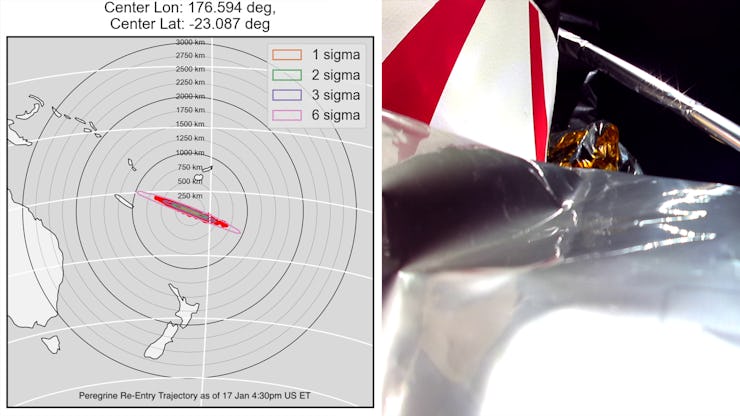Astrobotic's Peregrine Lander Is Making a Fiery Re-Entry to Earth Right Now
The fate of the Astrobotic Peregrine lunar lander is sealed.

The Peregrine lander from Pittsburgh-based company Astrobotic almost became the first privately-owned robot to reach the Moon’s surface. But it’s not to be.
Shortly after launching two weeks ago, Peregrine began running out of fuel due to a failure in the propulsion system, and the team realized it wouldn’t reach the Moon safely. The only remedy is to destroy the craft.
Officials sent Peregrine back towards Earth to burn apart. In a recent statement, Astrobotic said their spacecraft would enter our planet’s atmosphere over the Pacific Ocean at about 4:00 p.m. Eastern on Thursday. According to an Astrobotic statement published on X (formerly Twitter) at 11:19 a.m. Eastern on Thursday, Peregrine is just 30,000 miles from Earth — or 1/16th the farthest distance the mission reached in space.
“The team has been continuously monitoring our re-entry analysis with NASA, which indicates a re-entry path… with no anticipated hazards,” the company said Thursday.
The space agency paid Astrobotic $108 million to transport five scientific instruments to the Moon’s surface. Peregrine’s success would have ushered in NASA’s new Commercial Lunar Payload Services (CLPS). To save on costs, NASA aims to pay for Moon transportation services instead of building out robotic lunar fliers itself. By contracting several different delivery servicers, NASA also hopes trips to the Moon will become more common. NASA is working on the infrastructure of its Artemis missions to create a sustained human presence on or around the Moon later this decade.
CLPS has several flights lined up for 2024. As soon as February, the next CLPS partner, Houston-based Intuitive Machines, will launch its IM-1 mission to the Moon’s south pole — and may take the prize for the first private lander on the lunar surface.
No U.S. spacecraft has landed on the Moon since 1972, when Apollo 17 brought the final trio of astronauts to the lunar surface.
Several countries and companies have attempted, but failed, in recent months to land there. The Hakuto M1 lunar lander from Japanese company ispace crashed on the Moon in April 2023. Russia’s Luna-25, the successor to the 1976’s Luna-24, crashed there too in August 2023. The Beresheet lander from Israeli company SpaceIL also crashed in April 2019.
Some landing attempts have been successful. India’s Chandrayaan-3 reached the Moon’s surface in August 2023, making the Southeast Asian country only the fourth to reach Earth’s natural satellite. China has had a series of successes with its Chang’e fleet. Its most recent mission, Chang’e-5, in 2020 made the first Moon rock retrievals since 1976.
The end of the week might bring some lunar-landing success. As soon as Friday, Japan will attempt to land its Smart Lander for Investigating Moon (SLIM) spacecraft to the Moon, and could become the fifth nation to accomplish this difficult feat.
This article was originally published on